Federal Tax Reform Could Turn City’s Housing Crisis into a Humanitarian Disaster
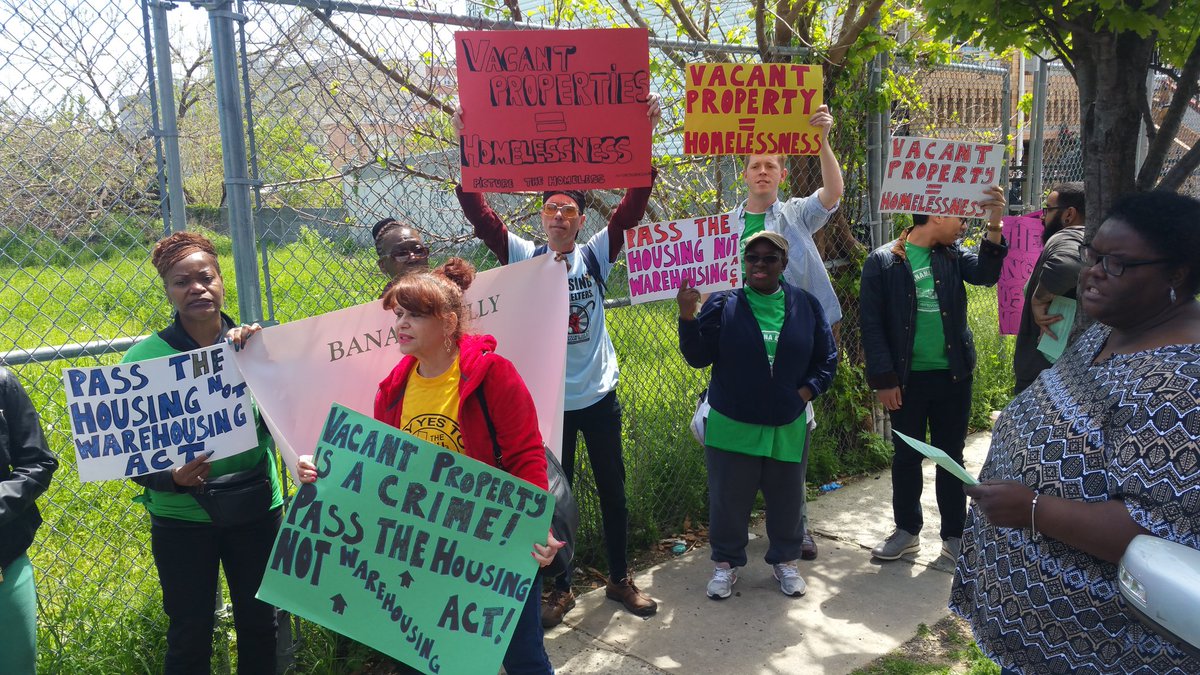
protesting unused vacant property (via @pthny)
In New York City, the demand for affordable housing far exceeds supply. Seventy percent of the city’s homeless shelter residents are families. Families who should be in homes.
Now, as the United States House of Representatives and Senate look to the conference committee to reconcile their respective tax reform bills, the housing crisis that began in the 1980s will become a catastrophe unless we, the people, intervene.
On paper, both the House and Senate plans retain the Low Income Housing Tax Credit (LIHTC) — which funds 90 percent of the nation’s affordable housing developments. However, the House tax bill eliminates tax-exempt private activity bonds (PABs) that fund half of all LIHTC projects.
Although the Senate bill retains PABs, both bills cut the corporate tax rate from 35 percent to 20 percent, dramatically reducing the value of tax credits that fund the remainder of LIHTC projects.
Also included in the Senate bill is an amendment that imposes what amounts to an international alternative minimum tax on any corporation with significant foreign operations. As a result, some large corporate investors might be deterred from claiming the LIHTC.
No matter how the reconciliation pans out, it is clear that, if passed, federal tax reform will devastate more than a million low-income New Yorkers searching for homes. And this isn’t the first federal policy to squeeze out affordable housing.
Under President Reagan, government spending on subsidized housing was slashed from $26 billion to $8 billion, contributing to a dramatic spike in homelessness. As a private sector solution, Reagan signed the LIHTC into law in 1986 to counterbalance the cuts to direct federal spending.
LIHTC’s market-based answer to affordable housing was successful enough that subsequent administrations maintained the program while continuing to whittle away at Housing and Urban Development (HUD) funds. LIHTC became the best — or rather, only — hope for Americans in need. But in cities like New York, LIHTC wasn’t enough to mitigate the surge and suffering of homelessness.
Although LIHTC helped develop or preserve approximately 122,000 affordable properties in New York City from 1994 to 2014, the city still endured a net loss of 150,000 rent stabilized apartments, leaving tens of thousands of New Yorkers with nowhere to go but the street or a shelter.
Mayor Bill de Blasio responded to this crisis with a pledge to add 100,000 affordable units by 2020. But experts at Novogradac & Company estimate that, if the House tax bill passes, that number could fall by two thirds.
Even if PABs are retained in the reconciled bill, the corporate tax rate reduction alone will result in the loss of around 300,000 affordable units nationally.
By squeezing the funding pipeline for affordable housing tighter than ever before, both bills crush the supply of affordable housing and the low-income families that rely on it.
This cannot happen — not on our watch, not in our city, and not in our country. This isn’t a partisan issue, it’s a moral one. We have a duty, to our city and our neighbors, to speak out against any provision that would threaten the supply of affordable housing at this most critical time in our country’s history.
Although the House and Senate have approved their respective bills, the final version has yet to be agreed upon. Now is the time to urge our representatives to reject any final bill that removes the tax-exempt status of PABs and cuts the corporate tax rate.
***
George McDonald is founder and president of The Doe Fund. On Twitter at @GeorgeTMcDonald and @TheDoeFund.
***
Have an op-ed idea or submission for Gotham Gazette? Email This email address is being protected from spambots. You need JavaScript enabled to view it.
The City’s Bogus Compromise with Uber Would Hurt Riders with Disabilities

(photo via nyc.gov)
The hustle and bustle of New York is a part of its identity: we New Yorkers are always on the move. Our officials must fight for equal access to transportation, but as those of us with disabilities know, accessible methods of travel are shamefully limited. This is why the Taxi and Limousine Commission (TLC) has apparently been negotiating with private for-hire car companies like Uber and Lyft on the issue of wheelchair accessible taxis for several months.
This could have been an encouraging sign, but last week, it became clear that TLC is more interested in cutting a backroom deal with Uber and Lyft than it is with seriously listening to wheelchair users. The TLC has even gone so far as to ignore sensible calls for action in favor of a proposal initiated by the very same companies who created this crisis.
It has been clear that the city’s yellow taxi accessibility program is on the ropes – mainly because accessible taxis cost much more to operate and maintain than regular taxis. The TLC created the Taxi Improvement Fund (TIF), which takes 30 cents from each yellow cab ride to support drivers with accessible vehicles. But it has become increasingly clear to disabled riders that the current TIF program is not enough. Drivers are struggling to make ends meet, and the program is in danger of complete collapse.
That is why I have called upon the TLC to mandate that ride-hail companies, including multi-billion dollar giants like Uber and Lyft, contribute to the TIF. Since these companies have proven to less than friendly to disabled riders, they should have to pay a higher fee.
This plan is simple and effective. The TIF is a city fund overseen by the city, rather than a state tax, so this tweak wouldn’t require any changes to state law or any approval from state officials. (For some reason, the TLC recently tried to convince me that it would require state approval, but that is just not true.) Not only is it easy to implement, but this proposal would provide critical support for the drivers who need it most and help wheelchair users navigate the city.
It is a win for all stakeholders. Elected officials get an easy fix to a critical problem, cab drivers already doing the right thing get support they need, and New Yorkers with disabilities get greater transportation access.
Not so fast, though.
The TLC is considering a proposal – one that originated with Uber, Lyft and other for-hire vehicle providers themselves – that would create a two-year pilot program allowing companies who opt in “to provide accessible service via a central dispatch system.”
The currently-negotiated plan is that companies would provide accessible vehicles to riders who request them in under 15 minutes, 60 percent of the time in the first year and 80 percent in the second.
I know that this proposal will not result in any meaningfully positive changes for wheelchair users like myself.
Despite from the fact that these companies have a track record of promoting falsehoods when it comes to accessibility and have frequently avoided actually putting accessible vehicles on the road, there is nothing in this proposal to hold them accountable.
In fact, it looks like this so-called pilot program would amount to little more than words.
This potential compromise also does nothing to solve the TIF crisis and would likely lead to the end of the city’s accessible taxi program. This outcome would leave the many riders who depend on wheelchair-accessible vehicles in the hands of private companies, who, at the very best, would only promise to provide a car within 15 minutes 60 percent of the time.
In a city with a terrible track record on wheelchair accessibility – have a look around any subway station – ceding this ground is an unacceptable outcome that will leave New Yorkers with disabilities without a reliable method of transportation.
That is an outrage. Fortunately, a sensible solution is out there – but it is up to the TLC to do the right thing, and the time is now.
***
Dustin Jones is president and founder of United for Equal Access New York, a disability advocacy group.
***
Have an op-ed idea or submission for Gotham Gazette? Email This email address is being protected from spambots. You need JavaScript enabled to view it.
High Stakes for Affordable Housing in City Council Speaker Race
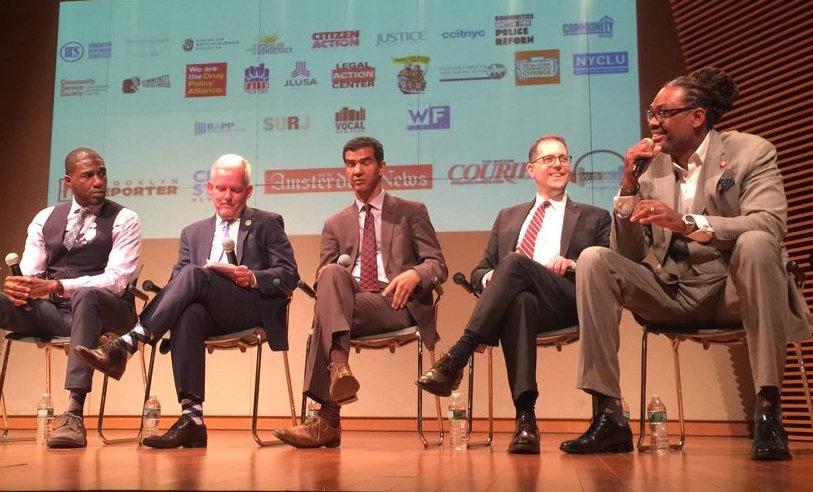
Robert Cornegy (far right) at a City Council Speaker forum (photo: @RobertCornegyJr)
Eight members of the New York City Council are asking their colleagues to elect them as the new Speaker after the new legislative body is seated January 1.
Seven of the candidates oppose allowing Airbnb and other on-line platforms to continue their assault on our scarce affordable rental housing. But one of them, Robert Cornegy, Jr. of Brooklyn, does not.
In a June 2016 opinion piece for City & State, Council Member Cornegy argued that Airbnb brings extra income to his struggling constituents in Crown Heights and Bedford-Stuyvesant, ensuring that they can continue to live in the rapidly gentrifying neighborhoods. This column was straight out of the Airbnb playbook, and contradicted by the fact that roughly 75 percent of Airbnb revenue in New York City is generated by commercial hosts with multiple listings, not “regular folks” renting their own place.
North and Central Brooklyn are the epicenter of gentrification in New York City, and Airbnb has played a destructive role. In Council Member Cornegy’s district, there were some 3,400 listings for Airbnb in October. Of these, almost 1,300 were for entire homes. If these “entire homes” are in apartment buildings, then they are illegal, as short-term rentals are against the law if the tenant is not present. (Renting out a room while the tenant is living in the apartment is not illegal, although tenants who do so risk eviction if the landlord finds out.)
Airbnb’s negative impact on Council Member Cornegy’s district is merely one part of a larger trend in the borough. Four City Council districts stretching from Williamsburg to Crown Heights are represented by Steve Levin, Antonio Reynoso, Laurie Cumbo, and Cornegy. These four districts combined had Airbnb listings for more than 16,000 units in October. By contrast, the top four Council districts in Manhattan combined had 10,800 listings.
A study last March by Inside Airbnb tallied the host photographs in the 72 predominately African-American neighborhoods in the city. The Airbnb host population in these communities was 74 percent white, while the white resident population was only 13.9 percent. White hosts in these neighborhoods earned 73.7 percent of the income from Airbnb rentals. Despite Airbnb’s claim that they make it possible for people of color to supplement their incomes, it is clear that the newer, white residents in these gentrifying neighborhoods are the main beneficiaries of the “sharing economy.”
So, who suffers? These units have been withdrawn from the rental market because short-term rentals are more profitable. Long-term residents therefore face a tighter market, and are subject to harassment and rent gouging.
This is not only a Brooklyn or even a New York problem. From Vancouver to London, local governments are taking action to curb short-term rentals. Airbnb’s response is to stonewall, and enlist surrogates to spin its public relations web.
I have a friend whose family owns a restaurant in a year-round resort town in the northeastern United States. He told me recently that until a couple of years ago, the cooks and waiters could share a house for $700 to $800 per month. Now there are no such rentals available, because owners can make that much in a weekend through Airbnb.
The sheer scope of this crisis makes the future of New York City’s government all the more critical. The rest of the nation and even the world look to us as a model for policy and politics, and we must do everything we can to make our housing market more affordable.
Ensuring that the next Speaker of the City Council is a true advocate for tenants, and for preserving our threatened stock of affordable rental housing, is the first next step in addressing the host of problems we face: weakened rent laws, lax enforcement by state and city, predatory speculators paying excessive prices for apartment buildings with an eye to driving out the rent-regulated tenants, constant upward pressure on rents, construction as harassment, and more.
We cannot afford to have in our house of government a Speaker who will not fight to protect the homes of its citizens. I urge Council Member Cornegy’s colleagues to take a look at this before casting their votes, and show that they stand with tenants, not the companies that are forcing them out.
***
Michael McKee is treasurer of Tenants Political Action Committee. On Twitter @TenantsPACNY.
***
Have an op-ed idea or submission for Gotham Gazette? Email This email address is being protected from spambots. You need JavaScript enabled to view it.
De Blasio Administration Disappoints at Rikers Hearing
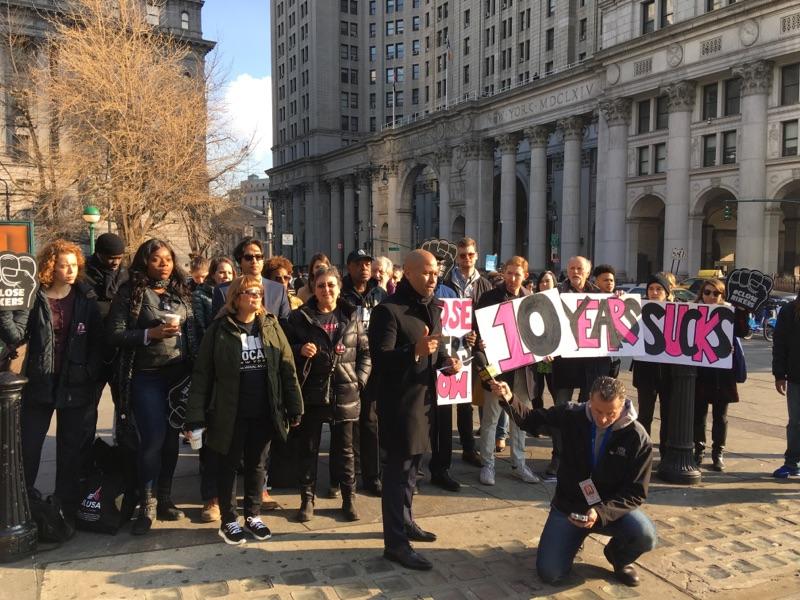
Glenn Martin & JustLeadershipUSA (photo: @GlennEMartin)
New Yorkers depend on City Council hearings to hold agencies accountable and to demand transparency from the mayor’s administration. On Monday, what the City Council members of the Fire and Criminal Justice Committee got instead was a dismissive attitude cushioned in lofty rhetoric from a mayor’s office that seems unwilling or unable to make closing the jails on Rikers Island a priority.
Time after time, representatives from Mayor Bill de Blasio’s Office of Criminal Justice (MOCJ) and the city Department of Correction (DOC) sidestepped important questions, reaffirmed their adherence to a too-long ten-year timeline to closing Rikers jails, and adamantly refused to offer a concrete plan for how to achieve even that goal.
Several Council members were quick to point out that a ten-year timeline is not justified by any information that has been presented to them, but the de Blasio administration made clear that they see the challenge of closing Rikers jails as a “steep climb,” and something that will be nearly impossible to achieve in anything less than ten years.
Glenn E. Martin, president of JustLeadershipUSA and founder of the #CLOSErikers campaign, voiced a concern that many were palpably feeling during the hearing when, in his testimony, he described Mayor de Blasio’s actions on closing Rikers as “opaque, narrow, and visionless.” Martin and others voiced concerns over some of MOCJ’s proposals, including the use of risk assessments in evaluating the population at Rikers Island, as well as the language used by new DOC Commissioner Cynthia Brann, who constantly referred to people incarcerated on Rikers as “inmates.”
On Twitter, Martin noted that Brann’s call for cultural change at Rikers – what he sees as an untenable given the deeply-entrenched culture of brutality on the island – was rendered meaningless by her refusal to “recognize the humanity of the people there.”
There were other moments in testimony from MOCJ and DOC offering insight into how the mayor is approaching the problems presented by Rikers Island.
MOCJ Director Liz Glazer reaffirmed her office’s commitment to using data to help reduce the number of people incarcerated at Rikers, while pointing out that the seriousness of the charges that many are facing may make it difficult to immediately relocate or release several of those people. Additionally, DOC Commissioner Brann highlighted some of the increased programming that has been introduced at Rikers, and walked Council members through some of the recent reforms that are a result of oversight efforts from the court-appointed Nunez Monitoring Team.
However, even with these moments, the hearing felt like a missed opportunity to communicate the mayor’s vision, if he has one, to a city eager for concrete action and meaningful change. “While today's hearing should have been an opportunity to engage with the administration and learn about what they have done and intend to do, the hearing showed that the mayor is simply not interested in crafting meaningful and bold solutions in the effort to close Rikers,” said Martin.
What was perhaps most shocking, however, was not just how little was said about what’s next, but how little was said about whatever has been achieved up to this point. The City Council was given very little substantive information to work with, and was instead forced to reckon with the fact that, in many ways, the mayoral administration’s work on closing Rikers still sits at square one. In fact, judging by the few proposals and initiatives that were discussed by the administration, it would appear that they still do not understand the scope or the urgency of this issue.
Much of the testimony offered from the mayor’s representatives felt like it could have been spoken, without changing a word, several years ago. This is despite what the mayor claims has been significant progress on criminal justice reform throughout the second half of his first term. Time and again, MOCJ and DOC testimonies were centered on platitudes about the challenges that remain and the general vision that the mayor reluctantly adopted when he did finally agree that the city should work to close the Rikers jail complex.
But that was pretty much all they offered, and that’s the problem.
Rikers Island continues to be a destructive force for New York’s communities, budget, and conscience. It is, as Comptroller Scott Stringer has said, a stain on the moral fabric of our city. For this administration to offer little more than empty words and half-hearted ideas is a true disappointment for all of the New Yorkers eager to work with this mayor to end the trauma that results from this national embarrassment. Perhaps most importantly of all, this administration’s attitude was a deeply painful insult to the people who’ve been directly harmed by Rikers, many of whom were in the audience, looking on as the mayor’s representatives seemed to look past them.
***
Shanequa Charles is a #CLOSErikers campaign member.
***
Have an op-ed idea or submission for Gotham Gazette? Email This email address is being protected from spambots. You need JavaScript enabled to view it.
Yeshiva-Gate Could Imperil De Blasio’s Second Term
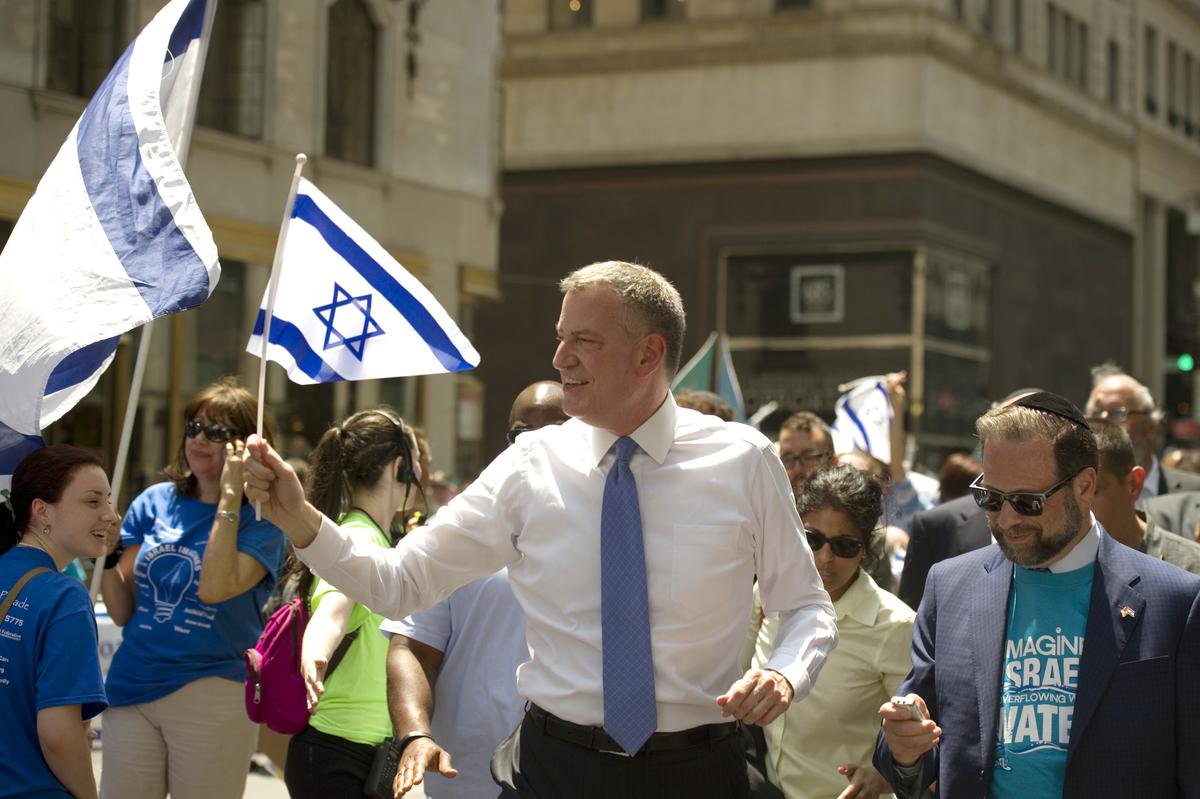
Mayor de Blasio (photo via The Mayor's Office)
For Mayor de Blasio, controversy over some ultra-Orthodox Jewish day schools’ duty to provide students with required secular studies may turn into a significant second term scandal. Yeshiva-gate, as it could be called, may imperil de Blasio’s next four years, after the mayor kicked the can down the road throughout his first term, with a long-stalled investigation still incomplete.
The Mayor-controlled city Department of Education is obligated under State Education Law to assure that nonpublic schools within the district provide education “substantially equivalent in amount and quality” to requirements for public school students. This includes consistency with State Learning Standards for all children ages 6 – 16 in English, social studies, math, science, technology, visual arts and music, physical education, career and home studies, health, and library/information skills.
The Mayor understands this mandate, having stated at a recent town hall meeting, “We have a legal requirement to make sure that the proper education happens in every kind of school.”
But a 86-page September report, “Non ≠ Equivalent,” by Yaffed, an advocacy organization, documents that a sub-group of ultra-Orthodox yeshivas provide far from adequate secular studies, with male adolescents especially short-changed. Many students have come forward attesting to the crippling economic and social effects of their inability to communicate in English and their ignorance of basic math, science, and technology. The Netflix documentary “One of Us,” as well as Yaffed-produced videos, present numerous heart-breaking examples of ultra-Orthodox yeshivas’ systemic flouting of the Education Law. Press exposés have appeared in the Times, Post, Daily News, NY1, and CBS, among others.
Despite this overwhelming evidence, a promised report by the Department of Education has failed to materialize. After over three years and numerous missed deadlines only six of the 39 schools supposedly under review have been visited and then only under strict yeshiva controls. The investigation has now taken more time than the Warren Report on the Kennedy assassination yet there is no end in sight. Chancellor Carmen Fariña has repeatedly side-stepped the issue, dismissing criticism as politically-motivated.
Enter the New York State Court of Appeals, the state’s highest court. Last February, in People v. Flanagan, the Court interpreted the elements of Penal Law § 195.00, Official Misconduct. There, a student’s heist of $3,000 worth of school electrical equipment eventually led to the conviction of a high-ranking police official who failed to pursue the investigation on behalf of the student’s father, a friend. The Court held that “the defendant, acting alone and with others in his official capacity, caused the abdication of the inherent duty to investigate...where there was overwhelming evidence.” Sound familiar?
Further, the required mental state for conviction of Official Misconduct is “the intent to obtain a benefit or deprive another of a benefit.” Here the Mayor’s Yeshiva-gate actions fail both prongs. The yeshivas gain from the Mayor’s failure to assure legal compliance by continuing to receive millions of dollars in public aid provided to them for ostensibly secular purposes. For de Blasio, behind the thin veil of his dilatory investigation, is the clear benefit of Orthodox leaders’ electoral support, with thousands of bloc votes supplied by their followers. The other side of the coin is the deprivation to yeshiva students of mandated secular studies. Case law makes clear that the benefit and deprivation need not be monetary and the official’s actions don’t have to be successful. Just the attempt is enough.
A strong case can be made that the Mayor is guilty of illegal action (“malfeasance” in legal terms) and inaction (“nonfeasance”) in this respect, violating both subsections of Section 195.00. A Freedom of Information Law request by Yaffed for City communications on the yeshiva issue was filed years ago yet is still unanswered. If the FOILed documents are ever produced – or unearthed by prosecutors doing their job – they will likely reveal orders to stymie the DOE’s yeshiva report. Just as glaring is the Mayor’s obvious inaction, a crime since he has a duty to investigate, as in Flanagan.
Similar charges are viable under the related Penal Law, Obstruction of Government Operations. There appears to have been interference with the routine administration of required nonpublic school oversight. That, too, is a crime.
All of this makes de Blasio vulnerable to removal from office by the Governor under section 9 of the City Charter. While he might be sorely tempted, it is unlikely that Cuomo would take such a step after de Blasio’s re-election victory. Removal over Yeshiva-gate would also pit Cuomo against the Chasidic community, a statewide, as well as local, political force.
Should the Manhattan District Attorney, who has jurisdiction, bring and win a case carrying a jail term of up to a year, resignation under pressure could occur. De Blasio has escaped D.A. Cyrus Vance’s clutches before, coming close to breaking election laws and earning Vance's scorn but not charges. Now Vance is under greater pressure to prosecute the powerful. This time the Mayor may have stepped over the line.
***
David C. Bloomfield is Professor of Education Leadership, Law and Policy at Brooklyn College and The CUNY Graduate Center. He is the author of American Public Education Law, 3d edition and other works. On Twitter @BloomfieldDavid.
***
Have an op-ed idea or submission for Gotham Gazette? Email This email address is being protected from spambots. You need JavaScript enabled to view it.
Shut Down Rikers Island, and Don’t Replace It

Rikers Island (photo: Michael Appleton/Mayor's Office)
Due to the work many have done to illuminate the dehumanization and torture rampant on Rikers Island, city officials are finally proposing tangible steps to shut it down. This Monday, December 4, the New York City Council will hear testimony on progress being made toward closing the Rikers Island jails. Much of the discussion around closing Rikers jails, sure to continue Monday, centers on reducing the overall jail population in the city, but also on replacing available jail space.
As politicians and city agencies share plans to shut down the island’s ten-jail complex, it is imperative that the people of New York recognize the impact of these proposals: the modernization and adaptation of New York City’s jails will ultimately expand the scope of surveillance and imprisonment in the city and state.
The challenge going forward is to resist the prevailing attitude that the horror of jail is unique to Rikers Island and not inherent to the institution of jail itself, and to prevent the expansion of the jail system under the guise of reforms, improvements, and repairs. Critical Resistance NYC and the imprisoned organizers with whom we work recognize that jail systems cannot be converted into something humane and that the solution to the violence of Rikers cannot be a new kind of imprisonment.
Mayor Bill de Blasio’s plan calls for a ten-year process of depopulation, renovation, and new construction that will eventually result in the closure of Rikers, but we call out these strategies, outlined in his Smaller, Safer, Fairer “roadmap” for closing Rikers, as simply an extension to the life of the system. Closing Rikers only to replace it with new “state-of-the-art” jails and an expanded network of technologically-driven monitoring does nothing to alleviate the material consequences of detention and imprisonment or to curtail the reach of the prison industrial complex in New York. Instead, the city must implement tangible policies that bring us closer to ending the use of pre-trial detention altogether.
With millions of dollars allocated for repairs and technological upgrades to existing facilities on Rikers, the Department of Correction’s budget does not reflect the claim that we are on a path to divesting from the very system that produced the horrific conditions that now warrant the closure of Rikers. Repairs to facilities marked as problematic and slated for demolition squander funds that could otherwise be spent on life-sustaining services that address social and economic needs and on community-led initiatives for addressing harm and accountability in non-punitive ways.
The Mayor’s plan to shrink the jail population without more significantly shrinking the number of people who are policed, criminalized, and arrested in the first place is not an effective path to decarceration. Reductions that aim to stop the flow of people into the city’s jail system could start immediately – in particular, by putting an end to broken windows and community policing, which only increase police presence in our neighborhoods and broaden their jurisdiction over virtually every aspect of our lives, especially in communities of color. New York City must refuse imprisonment and mandated monitoring as sustainable solutions. Instead, we must build a city-wide system that guarantees transformative, voluntary social services as well as resources that support people released from jail in order to facilitate the immediate jail depopulation that will actually move us closer to closing Rikers while making any new jails obsolete.
The city’s decision-makers must abandon any process to close Rikers that feeds, expands, and further calcifies the city’s jail system. We cannot truly overcome the violent reality of Rikers if our solution to its abuses depends on deepening wasteful spending in other jails and new forms of surveillance and monitoring in our communities. We must work to shift priorities from imprisonment and control to supporting and amplifying true community-led solutions to conflict, harm, and violence that strengthen community stability and meet people’s needs.
***
Kate Hudson and Marlene Nava Ramos are members of the New York City chapter of Critical Resistance, a national, member-led organization that seeks to create genuinely healthy and stable communities that respond to harm without relying on imprisonment, policing, and punishment.
***
Have an op-ed idea or submission for Gotham Gazette? Email This email address is being protected from spambots. You need JavaScript enabled to view it.
Teaching Our Children Democracy
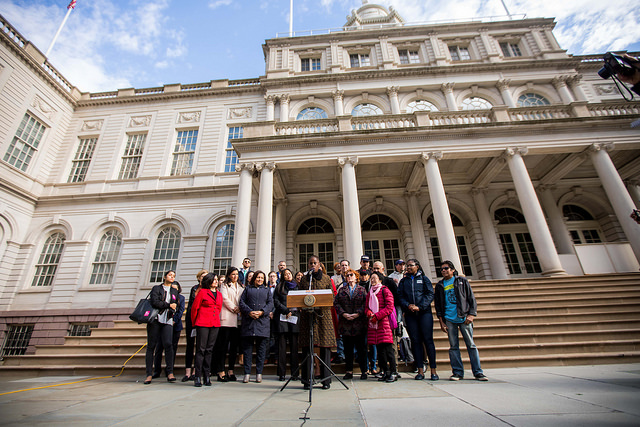
(photo: Benjamin Kanter/Mayor's Office)
People marching in the streets to protest the Trump administration’s policies often chant “This is what democracy looks like!” It’s a good reminder because many Americans have forgotten. Too many of us have taken for granted the rights and freedoms guaranteed us by the United States Constitution. But not anymore. Not when states threaten to arrest people who exercise their right to assemble and a president uses his office to bludgeon people whom he calls “losers.”
The New York Society for Ethical Culture was founded in 1876. Voter turnout that same year in the presidential race between Republican Rutherford B. Hayes and Democrat Samuel Tilden was 81.8 percent nationally. During the 2016 election, the national turnout was 60.2 percent. And this past election, the turnout in New York City was a record low 21.7 percent, a far cry from mayoral elections of decades ago. We can point to many reasons for the dramatic downturn in voter turnout over the past 140 years. But one of the biggest culprits is the lack of civics education in our country.
The purpose of civics is to prepare young Americans to be reflective citizens who value democracy. In that respect, we have failed. It’s clear to see where we went wrong. In the 1980s, policymakers started shifting focus to more “teachable” subjects like math. Some 20 years later, federal funding for social studies was eliminated. The result? A generation in which only one-quarter of U.S. high school students reach a proficient standard in civics assessment. Even more shocking, just two-thirds of students can name all three branches of government.
If there is a silver lining to the results of the 2016 election, it is the dramatic increase in civic engagement. Attendance at Women’s Marches across the country and the world stood in stark contrast to the number of Trump supporters attending his inauguration the day before. Subsequent marches organized by scientists and environmental activists rallied supporters from diverse constituencies for common causes. But a permanent return to civics must start with our youth.
As humanist philosopher John Dewey wrote, “Democracy needs to be re-born in each generation and education is its mid-wife.” We take that to heart at the New York Society for Ethical Culture. Through our Ethics for Children program, we work to empower youth and make them more aware and involved in civic engagement. With a lack of in-depth programs elsewhere, programs like this are a necessary tool for parents to supplement the civics education of their kids.
Civics education should start early in a child’s life so their basic rights as Americans are instilled from an early age. That’s why our program is aimed at children ages 3-12. Each month has a new theme but the overall goal is the same: To teach our children about how democracy works and keep them informed. Our democracy will not survive if future generations are unaware of their rights and responsibilities.
From today’s corrupt political leadership to the rise of bullying on the playground, there is so much about the world that is unethical. How can parents raise ethical, civic-minded children? It starts with how we introduce these ideas. It’s not enough to teach children ethics and civics. They need to experience them. Take your kids to marches and protests, such as the Youth Empowerment march our members joined. Have them attend lectures and events, like the public reading of the Declaration of Independence we hosted with civil rights attorney Norman Siegel. Make sure your kids have great role models. Let them know about kids their own age who are making a difference, like the teenagers suing the Trump administration over its inaction on climate change.
Teachers must once again take seriously their vocation to prepare children to take their places in our democracy, not only to find jobs in our economy. Current affairs can be brought into the classroom to highlight the importance of critical thinking. Student debates encourage teamwork and research, as well as the excitement of intellectual sparring. Field trips to local courthouses and governmental assemblies make democracy come alive.
Ours is a nation deeply divided over core social values. Trump’s presidency is only exacerbating this divide. Truth itself is threatened by a daily barrage of lies and “alternative facts” from the White House. People indulging in what we have come to call “confirmation bias” find information, news outlets, and online memes to fuel their righteous indignation and reject any other opinions. Whatever our differences, we who call the United States our home must find the goodness in one another and work together to call it forth. Democracy is sacred, and it is entrusted to us.
***
Dr. Anne Klaeysen is Leader of New York Society for Ethical Culture. On Twitter @EthicalNYC.
***
Have an op-ed idea or submission for Gotham Gazette? Email This email address is being protected from spambots. You need JavaScript enabled to view it.
For Safer City Schools, More Counselors, Fewer Cops
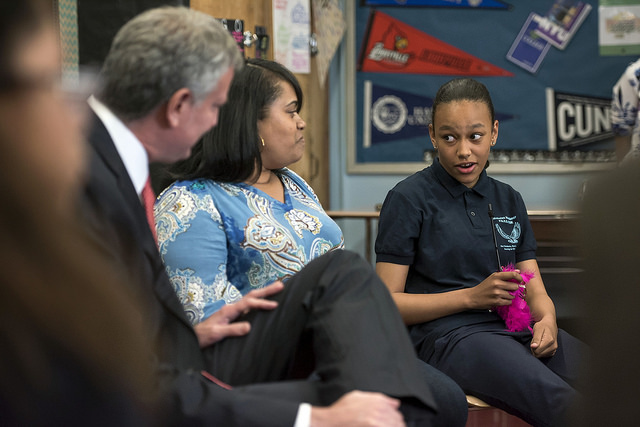
(photo: Ed Reed/Mayor's Office)
Our city is facing a tough question: how do we make schools safer?
New York City schools are on the precipice of returning to ineffective policies and practices like more policing and metal detectors that have harmed the students who are most in need. The city could and should instead take this opportunity to move further towards school culture and climate priorities that are designed to meet the social, emotional, and mental health needs of young people.
On Tuesday, New York City Council confronted the question of how to create safe schools in a hearing that included testimony from the NYPD, community groups, and, most importantly, young people.
It is young people who hold the answer to the question of how to make schools safer. Young people made clear that punitive and zero tolerance policies are ineffective to address conflict and often harm the students they are intended to support.
Solutions sought by young people address the root causes of conflict and fully recognize young people’s humanity. The Urban Youth Collaborative (whose organizational members include Make the Road New York, Future of Tomorrow, and Sistas and Brothas United) and the Center for Popular Democracy released a policy brief, “Young People’s Vision for Safe, Supportive, and Inclusive Schools,” which recommends dramatically increasing the number of counselors, providing comprehensive mental health supports, and infusing all schools with restorative practices. Absent from this list are metal detectors and police.
Young people’s experiences navigating bullying, conflict, and responses that offer little in the way of resolutions, such as the state-violence perpetrated by arrests, have led them to reimagine school safety by prioritizing what they need most: mental health care; guidance counselors and social workers; and restorative practices. All of their solutions are also backed by research.
Studies show that lower student-to-guidance counselor ratios reduce disciplinary incidents in schools, including ones involving weapons, and students and teachers report feeling safer. There is currently one full-time guidance counselor for every 407 students across the city school system, while the recommended ratio in high-need schools is one for every 100. By contrast, there is currently one NYPD School Safety Division personnel for every 207 students. Our schools will be safer and bullying will be reduced if New York City drastically increases the number of guidance counselors in schools.
Another recommendation from young people is to infuse restorative practices into all high needs schools to prevent conflict. When conflict does occur, restorative practices emphasize a rigorous process of holding each other accountable through communal dialogue. We know these processes work. As just one example, in Denver, within two years of implementing restorative practices in a school, incidents of fighting fell by 80 percent. To reap the benefits of restorative practices, they must be implemented in a robust way – providing funding for restorative justice coordinators and involving students and community in implementation.
Finally, young people want mental health care. New York City must implement a comprehensive mental health service continuum to connect school-based services with community and hospital-based care. In New York City, antiquated and misguided responses to mental health issues continue to utilize the NYPD as first responders to mental health crises in schools and communities. In just one year, the NYPD reported intervening 2,752 times while a child was experiencing a mental health crisis. In one case, a five-year-old black girl was handcuffed during a mental health emergency. Mental health workers need to handle mental health emergencies, and they need the resources to do so. Study after study shows that access to mental health care improves the mental health of young people and reduces disciplinary incidents, including fighting and other interpersonal conflict. Our schools will be safer and bullying will be reduced if New York City provides comprehensive mental health services to schools.
What is not on this list of programs to reduce bullying and make safer schools? Police and metal detectors. Policing in city schools creates extreme racial disparities -- just last week, the NYPD released shocking data illustrating this point.
For example, black girls are 14.4 times more likely to be arrested than their white peers, despite evidence that young people from different races do not misbehave at significantly different rates. Moreover, 97 percent of students middle-school age or younger who were arrested in school were black or Latinx, while they represent just 67 percent of the student population. Proponents of school policing and punitive disciplinary action often cite student safety as their primary justification. Yet there is no substantial evidentiary support for the proposition that police presence in schools create safe learning environments.
To the contrary, several studies show that young people are no safer after years of punitive practices and criminalization. Research shows that policing in schools does not reduce incidents of bullying or fighting. And young people feel significantly less safe. These practices also push young people out of schools entirely. Our schools can and must move away from policies and practices that are ineffective and dehumanize and criminalize young people.
Young people have the answer. We must listen to their calls for support.
***
Roberto Cabañas is the Urban Youth Collaborative Coordinator. Kate Terenzi is the Center for Popular Democracy’s Equal Justice Works Fellow, sponsored by Proskauer Rose LLP.
***
Have an op-ed idea or submission for Gotham Gazette? Email This email address is being protected from spambots. You need JavaScript enabled to view it.
Upstate New York is Home to Heavy Voter Turnout, Major State Investment and Minimal Job Growth
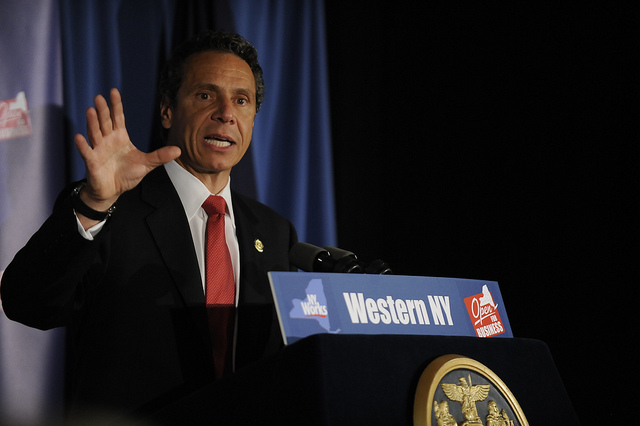
photo via The Governor's Office
Responding to criticism that his administration’s efforts to help the economy in upstate New York have been ineffective, Governor Cuomo recently stated at a luncheon in Glens Falls, a small upstate city, “It’s been a bad 50 years.” He added, “You’re not going to turn it around in a couple of years. But have we changed the overall trajectory? Yes.”
A great deal has been written not just about weak economic growth in upstate New York, but also about the lack of accountability and transparency of the state’s economic development agency, Empire State Development. It is essential to examine these concerns in the larger context of the health of upstate and how the region fits into the larger New York economy, the allocation of state government resources, and state politics.
A major political fact about upstate New York stands out in the context of any discussion about its destiny. Upstate New York provides a huge share of the vote in the state’s gubernatorial elections, which occur every four years in the even years not home to presidential elections.
Census 2016 estimates of the population of upstate New York, defined as all the counties north of New York City, Long Island, Westchester, and Rockland, were that the region was about 36% of the state’s total population. But in 2014 upstate New York was home to almost 49% of the gubernatorial vote, when Cuomo won re-election. New York City was home to only 26.5% of the statewide vote, although its share of the state population is 43%. That was equivalent to 1.01 million of the 3.81 million total gubernatorial votes.
These proportions were not just a fluke of one fairly uninteresting election. In 2010, when Andrew Cuomo was first elected governor, the upstate vote was 46.5% of 4.6 million votes on the governor line, while New York City was 29%. In 2006, when Eliot Spitzer easily won the governorship, upstate was 48% of the vote, while New York City was 28% of the 4.4 million votes. The city did do better in last year’s presidential election: in 2016, 2.7 million votes were recorded in New York City of the 7.7 million votes statewide, or 35%.
Upstate New York’s share of the vote in gubernatorial elections -- nearly half -- means that the area is politically important to whomever the governor might be and explains the focus on attempts to meet the needs of the people who live there. This, in combination with other factors, can help explain Governor Cuomo’s intense focus on Buffalo and other upstate areas, and the many economic development programs the state has launched to reinvigorate the upstate economy.
Downstate residents -- especially people from New York City -- ought to take upstate’s staggering disproportion of the vote as a wake-up call on the issue of how voter turnout may impact the allocation of resources. Not for the purpose of taking resources away from an area with a stagnant economy, but to make sure there are rational, articulated reasons and shared goals as to why state policies put resources in one place or another.
Let’s look at job growth over the past six years, measured as annual average employment in 2010 versus the annual average in 2016, and how upstate New York compared to the rest of New York and the nation.
Upstate New York gained 132,000 private sector jobs, growth of 5.8%, but lost 37,000 government jobs, making total job growth a meager 95,000 jobs, a gain of 3.3% from 2010 to 2016. Total state employment grew 851,000 jobs, with private sector growth of 916,000 jobs.
New York City gained 610,000 jobs overall, with 616,000 private sector jobs. The city gained 72% of the total number of jobs across the state. The city had a gain of 16% of jobs there compared to 2010, and a strong 19% in private sector job growth from 2010 to 2016.
Long Island and the northern suburbs (Orange, Rockland, Westchester is the metro area unit) gained over 7% in total jobs compared to 2010, and over 10% growth in the private sector.
New York State as a whole grew 10%, with 13% in the private sector, very similar to the national growth rates, which were 10.7% total growth and private sector growth about 13%. The figures, all 2016 compared to 2010, certainly show that upstate New York was growing far more slowly than the rest of New York and the nation as the United States emerged from the Great Recession that hit in 2008-2009.
Upstate New York has nearly 7 million people, meaning it has a larger population than at least 33 states, and has 3 million jobs. It is a substantial economic region itself, and, like many parts of the United States, its job base has been battered by recessions and loss of manufacturing jobs.
Upstate New York has 12 metropolitan areas, and its three largest fared better than a number of the metro areas with smaller core cities. The Buffalo-Niagara region and the Rochester metro region both gained about 30,000 private sector jobs, almost 7% growth from 2010 to 2016. The Albany area gained 34,000 private sector jobs, about 9%. The Syracuse area, upstate’s fourth largest metro area, grew more slowly, gaining only 3% in private jobs.
The Binghamton and Elmira areas, in the Southern Tier, and the Utica-Rome area in central New York, lost 10,000 jobs between 2010 and 2016, although 7,000 of the jobs were in government. Utica-Rome did not lose private sector jobs but had almost no growth in them either. The remaining regions varied in their growth patterns but in general had slow growth. Loss of government jobs in upstate New York stabilized by 2013 after several years of cutbacks as the economy and the state budget improved.
Job growth overall in New York has continued in 2017, but a recent report by the Federal Reserve Bank of New York stated that growth in the upstate New York economy has slowed in 2016 and 2017.
Governor Cuomo said that upstate New York has had a bad 50 years but the state had changed the trajectory. It is important to acknowledge the economic damage that occurred in upstate New York before Cuomo was elected in 2010 as one looks at economic development efforts his administration has undertaken to change the trajectory.
New York’s efforts include not just the activities of Empire State Development, but substantial budget allocations and other development tools. Given the range of initiatives, from the Buffalo Billion to Start-Up New York, new casinos, the nano-technology centers, the Regional Economic Development Councils, and other efforts, it would be unfair to say the New York State government is not trying to help upstate New York. It is trying.
The next columns in this series on the state’s economy and economic development efforts will look at these concerns together: the severity of upstate New York’s manufacturing and other job losses; the extent of the effort by the state government to put resources into upstate; whether resources are being used effectively or being squandered; and to what extent the outcomes of these initiatives are transparent and being reported in meaningful ways.
***
Jim Brennan was a member of the New York State Assembly for 32 years, where he chaired four committees. On Twitter @JimBrennanNY.
***
Have an op-ed idea or submission for Gotham Gazette? Email This email address is being protected from spambots. You need JavaScript enabled to view it.
GothamTalks: Protecting Your Voting Rights and Our Election Integrity

Gotham Gazette and New Leaders Council -- a nonpartisan, nonprofit leadership institute -- have partnered with Manhattan Neighborhood Network to create a series of video commentaries by New York City civic activists. GothamTalks is short video essays submitted through the New Leaders Council alumni network, which consists of hundreds of New Yorkers working in advocacy, government, campaigns, nonprofits, business, law, and other aspects of city life.
Like both the reporting we do at Gotham Gazette and the written op-ed columns we publish, the GothamTalks video commentaries range in subject, but are all meant to move the public discussion forward. Please watch, listen, and let us know what you think. Use #GothamTalks on social media, and tag us @GothamGazette and @NLC_NYC.
Note: The views expressed in GothamTalks are entirely those of the commentators, and not of Gotham Gazette or New Leaders Council.
************
November 17, 2017
Jarret Berg
Voting rights and election integrity
GothamTalks: Commentary from New York civic leaders

Gotham Gazette and New Leaders Council -- a nonpartisan, nonprofit leadership institute -- have partnered with Manhattan Neighborhood Network to create a series of video commentaries by New York City civic activists. GothamTalks is short video essays submitted through the New Leaders Council alumni network, which consists of hundreds of New Yorkers working in advocacy, government, campaigns, nonprofits, business, law, and other aspects of city life.
Like both the reporting we do at Gotham Gazette and the written op-ed columns we publish, the GothamTalks video commentaries range in subject, but are all meant to move the public discussion forward. Please watch, listen, and let us know what you think. Use #GothamTalks on social media, and tag us @GothamGazette and @NLC_NYC.
Note: The views expressed in GothamTalks are entirely those of the commentators, and not of Gotham Gazette or New Leaders Council.
************
March 14, 2018
Jordan Stockdale
Gentrification, and What To Do If You're a Gentrifier
March 12, 2018
Michael Pernick
Campaign Finance Reform
March 1, 2018
Crystal Hudson
Fighting Alzheimer's Disease & Supporting Caregivers of Those Suffering
November 17
Jarret Berg
Voting rights and election integrity
November 10, 2017
Elizabeth Adams
Getting involved locally
November 3, 2017
Max Markham
Voting in Local Elections